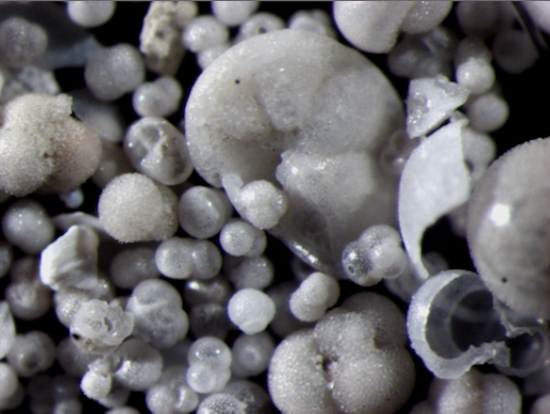In evolution, fossils reveal, ‘Court Jester’ gets last laugh

Less than a millimeter across, the shells of tiny organisms called planktonic foraminifera — like these from an offshore drilling site in the Atlantic Ocean — make up much of the sediment on the ocean floor. A study by UW–Madison researchers of similar sediment shows environmental changes at work in extinction of foraminifera species, but biological factors sparking the rise of new species.
Photo courtesy of Andy Fraass, University of Massachusetts-Amherst
The dominant factors in the rise and fall of the diversity of life on Earth has been a point of debate for scientists nearly as long as they have studied the processes of evolution.
In the 1970s, evolutionary biologist Leigh Van Valen began calling the case for biological factors (such as competition with other organisms for food, space and mates) the “Red Queen” hypothesis, after Lewis Carroll’s “Through the Looking-Glass” character who tells Alice she must run hard in Wonderland just to stay in the same place.
The alternative argument, backing the nonbiological forces of the environment (physical characteristics like chemistry and temperature or relative catastrophes like asteroid impacts), came to be known as the “Court Jester” hypothesis.

Peters, Dean L. Morgridge Chair of Geoscience
“This question — which one is pulling the strings? — is a big one for people who study the history of life on Earth,” says Shanan Peters, a University of Wisconsin–Madison geoscience professor. “And what we’ve found is that it’s actually both. They just play very different roles.”
Peters and Clay Kelly, a fellow UW–Madison geoscience professor, chose to pit the Red Queen and Court Jester against each other on the high seas, over planktonic foraminifera: tiny, shelled, ocean-dwelling creatures with an outsized impact on the planet and science. Their results were published online today (Jan. 9, 2013) by the journal Nature.
Foraminifera live and die around the globe in almost every part of our oceans, eating just a step up from the bottom of the food chain and providing an enormous amount of biomass for individuals that are usually less than a millimeter long.

Kelly
Immense blooms of marine plankton that include planktonic foraminifera can be large enough to be visible from space, which makes for a great many shelled corpses sinking to the seafloor when those populations wane.
“In a small sample of sediment from the ocean floor you can have thousands of these shells from all sorts of foraminifera species going back 150 million years,” Kelly says. Using records compiled over decades by scientists studying foraminifera, Kelly and graduate student Andrew Fraass tracked the expansion and contraction of the organisms’ diversity — the number of known species — across millions of years.
“There are so many foraminifera, so widely distributed around the oceans, that their shells really are the ocean sediment,” Kelly says. “And we know enough about when certain species were alive that these fossil shells are actually used by geologists researching ocean and climate change and working in the energy sector to tell them how old sediment samples are.”
But those shells don’t always reach bottom in a shifting ocean.
Variations in temperature, pressure and chemical composition of seawater form a boundary in the water called the carbonate compensation depth, or CCD. Beneath the CCD, calcium carbonate dissolves, and shells like those of foraminifera never fall into the sediment.
“The position of the CCD is extremely dynamic, moving up and down in the water column in the deep sea with changes in global chemistry — especially related to atmospheric carbon dioxide levels, but to other things, too,” says Peters. “As physical changes to the Earth’s environmental systems alter physical aspects of the ocean like the CCD, we see it reflected in the pattern of sedimentation.”
“This question — which [factor] is pulling the strings? — is a big one for people who study the history of life on Earth. And what we’ve found is that it’s actually both. They just play very different roles.”
Shanan Peters
Kelly and Peters spent years poring over reports from international deep-sea sediment drilling expeditions, selecting more than 70 sites in the Atlantic Ocean basin where sediment cores reached down to the basalt layer that marks the volcanic creation of the sea floor. They noted the ages of continuous stretches of sediment deposits, with special attention to the gaps.
“Those points where time elapsed without significant accumulation of sediment, those correspond very strongly to periods Clay and Andy found when foraminifera diversity was declining,” Peters says. “That tells us in a pretty convincing way that those extinctions are correlated to physical changes in the environment the foraminifera were adapted to.”
On the other hand, times when new foraminifera species were appearing in the oceans bear little or no connection to periods of physical change in the ocean environment.
“That suggests to us that it’s the Red Queen, a more biologically driven phenomenon, tied to species origination,” Kelly says. “It may be that these biological differences allow more competitive new species to flourish.”
When successful foraminifera species spread out, it takes a dramatic force to unseat them.
“These plankton species have broad geographic distributions,” Kelly says. “To extirpate a plankton species, you have to knock off every population around the world. Whatever crisis or change happens to bring that about has to be equally broad in geographic extent.”
“Big, global, physical changes like that leave very strong, visible signals in our data,” Peters says. “The macrostratigraphy, the way we’ve overlaid these different data sources, shows a really strong reaction to the meteorite impact that caused a huge extinction about 65 million years ago at the end of the Cretaceous period.”
The researcher’s data comes unhinged at only one point. The diversity of foraminifera species and state of the sediment record uncouple at the transition from Eocene epoch to Oligocene epoch. That change, about 34 million years ago, shifted the globe from a greenhouse state in which alligators roamed the Arctic to an icehouse state in which — for the first time — the Antarctic ice sheet formed, and advancing and retreating continental glaciers became the norm.
“That suggests to us the possibility that major climate tipping points affect the biosphere in a way that is really different from normal, gradual warming and cooling that we see within any of those intervals,” Peters says.
It’s no stretch, according to Peters and Kelly, whose work is funded by the National Science Foundation, to extend that idea to the rate of change the planet is experiencing today with modern climate change.
“If we are in fact shifting the balance of the climate into a new state, we could potentially see a transition interval like we see documented here,” Peters says, “where the biosphere not only responds, but it responds to environmental changes in a different way than it has for a very long period of time.”
And the foraminifera themselves, which sequester atmospheric carbon when their shells are buried in ocean sediment, could contribute to the feedback of an ever more aggressive and unpredictable Court Jester.
“That’s an important topic for more study,” Peters said. “Given the key role of the foraminifera in the Earth system, a system thrown out of whack could be further perturbed by the response of the planktonic foraminifera themselves.”




